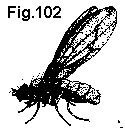Scatella stagnalis (Fallen) and perhaps other spp., Ephydridae, DIPTERA
 Zoom Fig. 102: Full view Shore
fly A-adult, B-egg, C-larva, D-pupa
Zoom Fig. 102: Full view Shore
fly A-adult, B-egg, C-larva, D-pupa Return to: CFREC Home Page
Adult - Shore flies in the genus Scatella are small (2 mm), black flies with reddish eyes and gray wings with clear spots. Shore flies resemble eye gnats, fruit flies, or vinegar flies in general shape. Shore flies are sometimes confused with darkwinged fungus gnats which are about the same size and color. (Darkwinged fungus gnats are shaped more like miniature mosquitoes and have relatively long legs and 50 antennae.)
Egg - Shore fly eggs are about 0.42 long and 0.2 mm wide. They are fairly rounded at both ends although there are small lobes on one end. The surface of the egg is covered with minute, faint polygons. The eggs remain white throughout the development of the embryo.
Larva - The tiny first stage maggots have two spiracles only at the rear. The next two larval stages have two spiracles on the rear and a spiracle on either side near the head. The mature maggot is about 2.6 mm long and 0.9 mm wide and 0.5 mm high. The hind spiracles are black and are located at the end of small but conspicuous tubes. The anterior spiracles each resemble the fingers of a slightly inflated rubber glove but these spiracles are microscopic and inconspicuous.
Puparium - The puparia of Scatella shore flies are brown to dark brown, curved, and tapered on both ends. The puparia are about 2.6 mm long and 0.9 mm wide. At the hind end, the spiracles resemble stiff antennae. On the front, the anterior spiracles stick out sideways like microscopic horns. The puparia are curved toward the top side of the developing fly.
Figure 102: Shore fly
Scatella stagnalis (Fallen) and perhaps other spp., Ephydridae,
DIPTERA
 Zoom Fig. 102: Full view Shore
fly A-adult, B-egg, C-larva, D-pupa
Zoom Fig. 102: Full view Shore
fly A-adult, B-egg, C-larva, D-pupa
Distribution - Shore flies in the genus Scatella are found throughout the United States, Canada and northern Mexico.
Scatella stagnalis also occurs widely in Europe and Asia. Most species naturally occur on muddy or marshy lake shores and intertidal zones of beaches.
Food Plants - Adult and immature shore flies feed on microscopic algae, dinoflagellates, bacteria, cyanobacteria, and other unicellular forms.
Damage - Neither adult nor immature shore flies feed upon ornamental plants. The damage caused by shore flies consists primarily in the excrement ("fly specks") left on the foliage of bedding plants and other ornamentals. Because shore flies are often confused with darkwinged fungus gnats, control efforts are often wasted (darkwinged fungus gnats may be harmful to plants but are relatively easy to control; shore flies are harmless but are very difficult to control with insecticides). Sometimes shore flies become so abundant in greenhouses that the sheer numbers of flies becomes a deterrent to customers browsing or even employees working.
Life History - Scatella shore flies are commonly found in greenhouses where they breed in algae growing on the potting mix, pots, benches and floors. Females scatter eggs right on the surface of the potting mix. The eggs hatch in 2 to 3 days. The larvae are found within the crust of algae and very top layer of potting mix. The maggots feed on bacteria and yeasts as well as diatoms and flagellates growing on the surface of the potting mix. The larvae mature in 3 to 6 days and pupate inside the skin of the last larval stage (this kind of pupa is called a puparium). The last larval skin affords the relatively tender and completely helpless pupa protection from environmental hazards (including insecticides). Some of the puparia are found on top of the potting mix or are very close to the surface. A new generation of adult flies emerges 4 to 5 days later. The adults crawl about on the surface of the potting mix, on the plants or they fly about the pots and plants. The flies move and fly rapidly but generally stay close to their breeding sites. The adults feed primarily on diatoms and flagellates on the surface of the potting mix or mats.
Perhaps because of the high biological activity of the surface of the potting mix, the protection afforded the pupa by the last larval skin, and the water repellent property of the adults, insecticides do not seem to readily suppress shore flies in greenhouses. Cultural methods of shore fly management include avoiding excessive use of water during irrigation, using the minimal optimum levels of fertilizers for adequate plant growth (and lower levels of excess fertilizers that encourage algal blooms), and a drier greenhouse environment. Algae on mats, benches, the walls or other structural members, and the soil beneath benches should be eliminated by using an approved algicide. Because shore fly maggots can also develop on rotting vegetable matter, general greenhouse sanitation should also help suppress shore fly numbers. For specific chemical recommendations see your Cooperative Extension Service publications on ornamental plant pest management.
University of Florida/IFAS Reference to Pest Control Guides